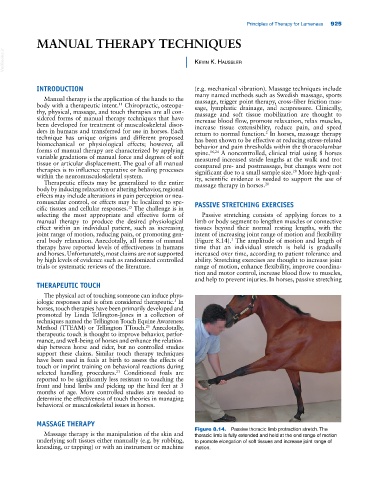Page 959 - Adams and Stashak's Lameness in Horses, 7th Edition
P. 959
Principles of Therapy for Lameness 925
MANUAL THERAPY TECHNIQUES
VetBooks.ir Kevin K. hauSSLer
INTRODUCTION (e.g. mechanical vibration). Massage techniques include
many named methods such as Swedish massage, sports
Manual therapy is the application of the hands to the massage, trigger point therapy, cross‐fiber friction mas-
body with a therapeutic intent. Chiropractic, osteopa- sage, lymphatic drainage, and acupressure. Clinically,
11
thy, physical, massage, and touch therapies are all con- massage and soft tissue mobilization are thought to
sidered forms of manual therapy techniques that have increase blood flow, promote relaxation, relax muscles,
been developed for treatment of musculoskeletal disor- increase tissue extensibility, reduce pain, and speed
ders in humans and transferred for use in horses. Each return to normal function. In horses, massage therapy
2
technique has unique origins and different proposed has been shown to be effective at reducing stress‐related
biomechanical or physiological effects; however, all behavior and pain thresholds within the thoracolumbar
forms of manual therapy are characterized by applying spine. 16,24 A noncontrolled, clinical trial using 8 horses
variable gradations of manual force and degrees of soft measured increased stride lengths at the walk and trot
tissue or articular displacement. The goal of all manual compared pre‐ and postmassage, but changes were not
therapies is to influence reparative or healing processes significant due to a small sample size. More high‐qual-
28
within the neuromusculoskeletal system. ity, scientific evidence is needed to support the use of
Therapeutic effects may be generalized to the entire massage therapy in horses. 20
body by inducing relaxation or altering behavior, regional
effects may include alterations in pain perception or neu-
romuscular control, or effects may be localized to spe- PASSIVE STRETCHING EXERCISES
15
cific tissues and cellular responses. The challenge is in
selecting the most appropriate and effective form of Passive stretching consists of applying forces to a
manual therapy to produce the desired physiological limb or body segment to lengthen muscles or connective
effect within an individual patient, such as increasing tissues beyond their normal resting lengths, with the
joint range of motion, reducing pain, or promoting gen- intent of increasing joint range of motion and flexibility
eral body relaxation. Anecdotally, all forms of manual (Figure 8.14). The amplitude of motion and length of
1
therapy have reported levels of effectiveness in humans time that an individual stretch is held is gradually
and horses. Unfortunately, most claims are not supported increased over time, according to patient tolerance and
by high levels of evidence such as randomized controlled ability. Stretching exercises are thought to increase joint
trials or systematic reviews of the literature. range of motion, enhance flexibility, improve coordina-
tion and motor control, increase blood flow to muscles,
and help to prevent injuries. In horses, passive stretching
THERAPEUTIC TOUCH
The physical act of touching someone can induce phys-
iologic responses and is often considered therapeutic. In
5
horses, touch therapies have been primarily developed and
promoted by Linda Tellington‐Jones in a collection of
techniques named the Tellington Touch Equine Awareness
25
Method (TTEAM) or Tellington TTouch. Anecdotally,
therapeutic touch is thought to improve behavior, perfor-
mance, and well‐being of horses and enhance the relation-
ship between horse and rider, but no controlled studies
support these claims. Similar touch therapy techniques
have been used in foals at birth to assess the effects of
touch or imprint training on behavioral reactions during
selected handling procedures. Conditioned foals are
23
reported to be significantly less resistant to touching the
front and hind limbs and picking up the hind feet at 3
months of age. More controlled studies are needed to
determine the effectiveness of touch theories in managing
behavioral or musculoskeletal issues in horses.
MASSAGE THERAPY
Figure 8.14. Passive thoracic limb protraction stretch. The
Massage therapy is the manipulation of the skin and thoracic limb is fully extended and held at the end range of motion
underlying soft tissues either manually (e.g. by rubbing, to promote elongation of soft tissues and increase joint range of
kneading, or tapping) or with an instrument or machine motion.

